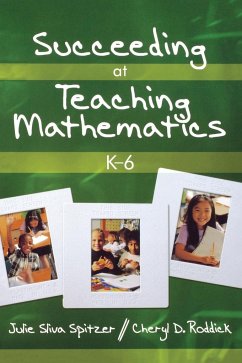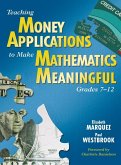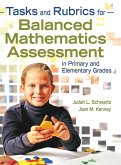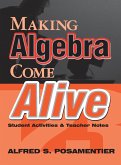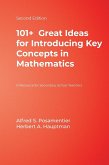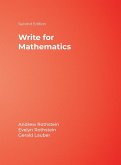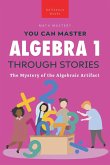- Gebundenes Buch
- Merkliste
- Auf die Merkliste
- Bewerten Bewerten
- Teilen
- Produkt teilen
- Produkterinnerung
- Produkterinnerung
This invaluable resource helps beginning educators focus on the big ideas in teaching mathematics and promote student engagement.
Andere Kunden interessierten sich auch für
![Teaching Money Applications to Make Mathematics Meaningful, Grades 7-12 Teaching Money Applications to Make Mathematics Meaningful, Grades 7-12]() Elizabeth MarquezTeaching Money Applications to Make Mathematics Meaningful, Grades 7-1280,99 €
Elizabeth MarquezTeaching Money Applications to Make Mathematics Meaningful, Grades 7-1280,99 €![Tasks and Rubrics for Balanced Mathematics Assessment in Primary and Elementary Grades Tasks and Rubrics for Balanced Mathematics Assessment in Primary and Elementary Grades]() Judah L. SchwartzTasks and Rubrics for Balanced Mathematics Assessment in Primary and Elementary Grades85,99 €
Judah L. SchwartzTasks and Rubrics for Balanced Mathematics Assessment in Primary and Elementary Grades85,99 €![Making Algebra Come Alive Making Algebra Come Alive]() Alfred S. PosamentierMaking Algebra Come Alive86,99 €
Alfred S. PosamentierMaking Algebra Come Alive86,99 €![101+ Great Ideas for Introducing Key Concepts in Mathematics 101+ Great Ideas for Introducing Key Concepts in Mathematics]() Alfred S. Posamentier101+ Great Ideas for Introducing Key Concepts in Mathematics97,99 €
Alfred S. Posamentier101+ Great Ideas for Introducing Key Concepts in Mathematics97,99 €![Write for Mathematics Write for Mathematics]() Andrew RothsteinWrite for Mathematics101,99 €
Andrew RothsteinWrite for Mathematics101,99 €![A Challenge of Common Knowledge I A Challenge of Common Knowledge I]() Barbara A. PierceA Challenge of Common Knowledge I20,99 €
Barbara A. PierceA Challenge of Common Knowledge I20,99 €![Algebra 1 Through Stories Algebra 1 Through Stories]() Jenny KellettAlgebra 1 Through Stories26,99 €
Jenny KellettAlgebra 1 Through Stories26,99 €-
-
-
This invaluable resource helps beginning educators focus on the big ideas in teaching mathematics and promote student engagement.
Hinweis: Dieser Artikel kann nur an eine deutsche Lieferadresse ausgeliefert werden.
Hinweis: Dieser Artikel kann nur an eine deutsche Lieferadresse ausgeliefert werden.
Produktdetails
- Produktdetails
- Verlag: Corwin
- Seitenzahl: 136
- Erscheinungstermin: 6. Dezember 2007
- Englisch
- Abmessung: 260mm x 183mm x 12mm
- Gewicht: 465g
- ISBN-13: 9781412927642
- ISBN-10: 1412927641
- Artikelnr.: 22837028
- Herstellerkennzeichnung
- Libri GmbH
- Europaallee 1
- 36244 Bad Hersfeld
- gpsr@libri.de
- Verlag: Corwin
- Seitenzahl: 136
- Erscheinungstermin: 6. Dezember 2007
- Englisch
- Abmessung: 260mm x 183mm x 12mm
- Gewicht: 465g
- ISBN-13: 9781412927642
- ISBN-10: 1412927641
- Artikelnr.: 22837028
- Herstellerkennzeichnung
- Libri GmbH
- Europaallee 1
- 36244 Bad Hersfeld
- gpsr@libri.de
Julie Sliva Spitzer brings a rich background in mathematics, technology, and special education. As an associate professor of mathematics education at San Jose State University, she teaches methods of mathematics instruction to aspiring educators and supervises their field experiences. Julie continues to enjoy inservice work with teachers Grades K-12. Julie's research interests include studying teacher and student attitudes toward teaching and learning mathematics, and best practices for teaching mathematics to learners with special needs. She is a frequent presenter at the National Council of Teachers of Mathematics Annual Meetings, the California Mathematics Annual Conference, and the International Group for the Psychology of Mathematics Education, North American Chapter.
Acknowledgments
About the Authors
Introduction
1. A Glimpse at Mathematics Instruction
Two Illustrations
Success in Teaching Mathematics
Summary
2. Standards-Based Teaching
Why Do We Need Standards for Teaching Mathematics?
The National Council of Teachers of Mathematics Principles and Standards
State and District Standards for Teaching Mathematics
The Relationship Between Standards and Standards-Based Mathematics
Textbooks
NCTM Curriculum Focal Points
Examples of Standards-Based Activities Involving Algebraic Thinking
Summary
3. Engaging Students in Learning Mathematics
What Is Engagement?
Engaging Learners in the Affective Domain
Affective Issues Related to Teaching and Learning Mathematics
Students Engaged in Learning Probability
Summary
4. Engagement Strategies for Special Populations
The Special Needs Learner
The Gifted Learner
The English Language Learner
Example of Engaging Learners in a Mathematics Classroom
Summary
5. Assessment
Developing Assessments: The Use of Backward Design
Types of Assessment
Rubrics
Grading and Assessment Schemes
Practical Ways of Assessing Throughout the Instructional Process
Tailoring Assessments for Special Populations
Data-Driven Instructional Practices
A Word About Standardized Tests
Summary
6. Putting It All Together
The Year at a Glance: Designing Your Curriculum
Making Connections Within Mathematics
Making Connections Across the Curriculum
Mathematical Connections Across Grades
Succeeding at Teaching Mathematics?and Loving It!
Appendix A
Appendix B
Appendix C
References
Index
About the Authors
Introduction
1. A Glimpse at Mathematics Instruction
Two Illustrations
Success in Teaching Mathematics
Summary
2. Standards-Based Teaching
Why Do We Need Standards for Teaching Mathematics?
The National Council of Teachers of Mathematics Principles and Standards
State and District Standards for Teaching Mathematics
The Relationship Between Standards and Standards-Based Mathematics
Textbooks
NCTM Curriculum Focal Points
Examples of Standards-Based Activities Involving Algebraic Thinking
Summary
3. Engaging Students in Learning Mathematics
What Is Engagement?
Engaging Learners in the Affective Domain
Affective Issues Related to Teaching and Learning Mathematics
Students Engaged in Learning Probability
Summary
4. Engagement Strategies for Special Populations
The Special Needs Learner
The Gifted Learner
The English Language Learner
Example of Engaging Learners in a Mathematics Classroom
Summary
5. Assessment
Developing Assessments: The Use of Backward Design
Types of Assessment
Rubrics
Grading and Assessment Schemes
Practical Ways of Assessing Throughout the Instructional Process
Tailoring Assessments for Special Populations
Data-Driven Instructional Practices
A Word About Standardized Tests
Summary
6. Putting It All Together
The Year at a Glance: Designing Your Curriculum
Making Connections Within Mathematics
Making Connections Across the Curriculum
Mathematical Connections Across Grades
Succeeding at Teaching Mathematics?and Loving It!
Appendix A
Appendix B
Appendix C
References
Index
Acknowledgments
About the Authors
Introduction
1. A Glimpse at Mathematics Instruction
Two Illustrations
Success in Teaching Mathematics
Summary
2. Standards-Based Teaching
Why Do We Need Standards for Teaching Mathematics?
The National Council of Teachers of Mathematics Principles and Standards
State and District Standards for Teaching Mathematics
The Relationship Between Standards and Standards-Based Mathematics
Textbooks
NCTM Curriculum Focal Points
Examples of Standards-Based Activities Involving Algebraic Thinking
Summary
3. Engaging Students in Learning Mathematics
What Is Engagement?
Engaging Learners in the Affective Domain
Affective Issues Related to Teaching and Learning Mathematics
Students Engaged in Learning Probability
Summary
4. Engagement Strategies for Special Populations
The Special Needs Learner
The Gifted Learner
The English Language Learner
Example of Engaging Learners in a Mathematics Classroom
Summary
5. Assessment
Developing Assessments: The Use of Backward Design
Types of Assessment
Rubrics
Grading and Assessment Schemes
Practical Ways of Assessing Throughout the Instructional Process
Tailoring Assessments for Special Populations
Data-Driven Instructional Practices
A Word About Standardized Tests
Summary
6. Putting It All Together
The Year at a Glance: Designing Your Curriculum
Making Connections Within Mathematics
Making Connections Across the Curriculum
Mathematical Connections Across Grades
Succeeding at Teaching Mathematics?and Loving It!
Appendix A
Appendix B
Appendix C
References
Index
About the Authors
Introduction
1. A Glimpse at Mathematics Instruction
Two Illustrations
Success in Teaching Mathematics
Summary
2. Standards-Based Teaching
Why Do We Need Standards for Teaching Mathematics?
The National Council of Teachers of Mathematics Principles and Standards
State and District Standards for Teaching Mathematics
The Relationship Between Standards and Standards-Based Mathematics
Textbooks
NCTM Curriculum Focal Points
Examples of Standards-Based Activities Involving Algebraic Thinking
Summary
3. Engaging Students in Learning Mathematics
What Is Engagement?
Engaging Learners in the Affective Domain
Affective Issues Related to Teaching and Learning Mathematics
Students Engaged in Learning Probability
Summary
4. Engagement Strategies for Special Populations
The Special Needs Learner
The Gifted Learner
The English Language Learner
Example of Engaging Learners in a Mathematics Classroom
Summary
5. Assessment
Developing Assessments: The Use of Backward Design
Types of Assessment
Rubrics
Grading and Assessment Schemes
Practical Ways of Assessing Throughout the Instructional Process
Tailoring Assessments for Special Populations
Data-Driven Instructional Practices
A Word About Standardized Tests
Summary
6. Putting It All Together
The Year at a Glance: Designing Your Curriculum
Making Connections Within Mathematics
Making Connections Across the Curriculum
Mathematical Connections Across Grades
Succeeding at Teaching Mathematics?and Loving It!
Appendix A
Appendix B
Appendix C
References
Index

